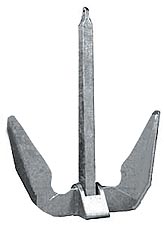nomadwilly wrote:
I think you got caught up in the hype on this anchor thing and would be better (or just as well) off w a claw anchor bigger than the one you had/have. I think it is/was a 33lb. If you had just gotten a 44lb claw your anchoring worries would have been over.
I don't believe that at all.* We had a number of bad experiences with the Bruce (as do a surprising number of other people we know) and when we almost lost the boat to the thing we decided to see if there was something better.* Other boaters we talked to at the time who had Bruces related similar bad experiences and it began to dawn on us that this anchor--- which is still incredibly popular--- is perhaps not what it's cracked up to be.
At that time the Rocna was almost unknown in the US.* We'd certainly never heard of it.* We were researching other anchor types when a post to the GB forum brought the Rocna name to our attention.* We asked a few experienced boaters in our marina about it but none of them had ever heard of it either.* So we looked into it, read a lot of stuff about it, talked to the company in New Zealand, and since it seemed from all the testimonials that it* was outperforming most other anchor types on a general basis, we bought one.* They have since become much more well known and popular in this country.* But at the time we got ours--- some five years ago I think--- they were quite unknown.* So we certainly didn't succumb to any "buy what other people have" fever since at the time nobody else around us had one.
Among the people we know who have had bad experiences with a Bruce are people with different anchor weights all the way up into the 60 or 70 pound range.* Having an anchor a mere eleven pounds heavier than the one we had would have made no difference whatsoever to the experiences we had, particularly the last one.
As I've said before I am convinced the Bruce is a poor design as a small anchor.* The fact a lot of people have good luck with them is, I believe, more due to the fact that most recreational boats are never really put to the test with their anchors rather than the Bruce is an effective design when scaled down to sizes most of our boats would carry.
Designs don't always work equally well when scaled up or down.* The Bruce is, in my opinion, a design that works very well at the sizes and weights of its original purpose, which is anchoring oil rigs in the North Sea.* But taking that same design and reducing it to a few feet across and some* 30, 40, 50 pounds or so, I believe there are far superior designs that set better and hold better in that size and weight range.
When we were starting our search for a better anchor I asked a very experienced, long-time sailor and marine engineer why the CQR was so popular.* It's a puzzling design to me because it's set up to move forward in the direction of pull (like a farmer's plow) rather than resist the pull.* The only resistance to the pull is the double-fluke design's tendency to dig down as it moves forward.* But if it doesn't dig down, all it will do is move forward.* So for years I'd wondered why they were so popular.* When I asked this guy--- who has a CQR on his own 40' sailboat--- he said its popularity was due primarily to the fact it was the first anchor to come out that stowed well on the bow of a sailboat.* It's why he bought his so many decades before.* So Eric's comment regarding an anchor's popularity due to its ease of storage is right on the money in my opinion.
One of the things that really impressed us about the Rocna was the first time we saw the design everything about the design made sense to us (unlike the CQR and the Bruce).* We could see immediately how every feature worked and why it worked.* So we felt-- -and after using it for all this time, still feel--- very confident about it because its design makes total sense to us.* I'm not going to say the Rocna is the best anchor ever because I have no data to back that statement up and there are too many variables to say that
any anchor is the best ever.* But in comparison to what we use to have, the Rocna is vastly superior.
-- Edited by Marin on Friday 28th of January 2011 01:49:40 PM


